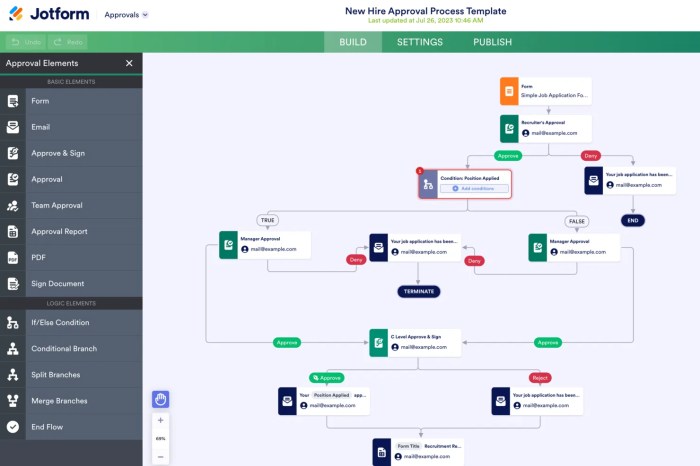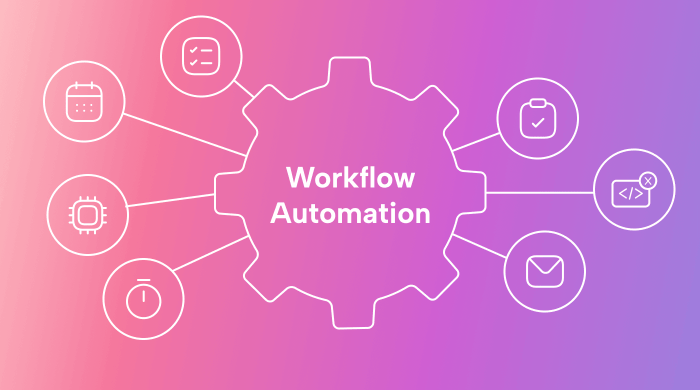CRM software with workflow automation revolutionizes business processes. By automating repetitive tasks, businesses can significantly improve efficiency, reduce errors, and boost productivity. This exploration delves into the core functionalities of CRM software, various workflow automation types, and the considerable benefits of their integration. We’ll examine strategies for selecting, implementing, and managing these systems, along with crucial security and data privacy considerations.
This guide provides a comprehensive overview of how businesses can leverage CRM software and workflow automation to streamline operations, enhance customer relationships, and ultimately drive growth. We will explore practical examples, best practices, and advanced techniques to help you navigate the complexities of this powerful technology and unlock its full potential.
CRM Software with Workflow Automation
Integrating workflow automation into your Customer Relationship Management (CRM) system is no longer a luxury; it’s a necessity for businesses aiming for efficiency and growth in today’s competitive landscape. This comprehensive guide explores the multifaceted aspects of CRM software enhanced with workflow automation, covering its definition, benefits, implementation, and advanced techniques. We’ll delve into choosing the right system, optimizing workflows, and addressing crucial security considerations.
Core CRM Functionalities and Workflow Automation Types
CRM software fundamentally manages customer interactions and data throughout the customer lifecycle. Core functionalities include contact management, lead generation and nurturing, sales pipeline management, marketing automation, customer service support, and reporting/analytics. Workflow automation, a key enhancement, streamlines these processes by automating repetitive tasks. Several types exist, including rule-based automation (triggered by specific conditions), event-based automation (triggered by events like email opens), and human-in-the-loop automation (combining automated steps with human intervention).
Workflow Automation’s Impact on CRM Efficiency
Workflow automation significantly boosts CRM efficiency by automating routine tasks, reducing manual effort, and minimizing human error. For example, automated lead assignment ensures leads are routed to the appropriate sales representatives promptly, while automated email sequences nurture leads and improve conversion rates. Automated reporting provides real-time insights into sales performance and customer behavior, enabling data-driven decision-making.
Comparing CRM Workflow Automation Implementation Approaches
Implementing workflow automation can be approached in various ways. A phased approach, starting with high-impact workflows, is often preferred. Alternatively, a comprehensive, system-wide implementation can be undertaken. The choice depends on the complexity of the CRM system, the organization’s resources, and its specific needs. Customization options vary across platforms; some offer extensive customization, while others rely on pre-built templates.
Careful consideration of these factors is crucial for successful implementation.
Benefits of Integrating Workflow Automation into CRM

The integration of workflow automation yields substantial returns on investment (ROI) and enhances operational efficiency across various aspects of the business. By minimizing manual interventions and streamlining processes, companies can experience significant cost savings and improved accuracy.
Case Studies and ROI of Workflow Automation, CRM software with workflow automation
A hypothetical case study: Company X, a mid-sized SaaS company, implemented automated lead qualification workflows. This resulted in a 25% increase in qualified leads and a 15% reduction in sales cycle time within six months. Another example: Company Y, a retail company, automated its customer service ticketing system, resulting in a 30% reduction in average response time and improved customer satisfaction scores.
Reducing Manual Tasks and Human Error
Automation significantly reduces manual data entry, freeing up valuable employee time for more strategic tasks. It also minimizes human error associated with repetitive tasks, ensuring data accuracy and consistency. This leads to improved reporting and more reliable decision-making.
Key Performance Indicators (KPIs) for Workflow Automation
Several KPIs can be used to measure the impact of workflow automation. These include lead conversion rates, sales cycle length, customer satisfaction scores, average handling time for customer service requests, and the number of manual tasks completed.
Automated vs. Manual CRM Processes: A Comparison
| Task | Time Saved | Cost Savings | Error Reduction |
|---|---|---|---|
| Lead Qualification | 50% | 10-15% | 20% |
| Customer Onboarding | 30% | 5-10% | 15% |
| Sales Reporting | 40% | 8-12% | 25% |
| Customer Service Ticket Handling | 25% | 5-8% | 10% |
Choosing the Right CRM Software with Workflow Automation
Selecting the appropriate CRM system with robust workflow automation capabilities requires careful consideration of various factors. This includes evaluating the software’s features, scalability, integration capabilities, and cost-effectiveness.
Factors to Consider When Selecting a CRM System
Key considerations include the size and complexity of your business, your specific workflow needs, your budget, the level of customization required, and the platform’s integration capabilities with other business applications. Scalability is crucial for accommodating future growth.
Comparing CRM Platforms Based on Workflow Automation
Different CRM platforms offer varying levels of workflow automation capabilities. Some may provide pre-built templates, while others offer extensive customization options. Consider platforms like Salesforce, HubSpot, Zoho CRM, and Microsoft Dynamics 365, each offering unique strengths in workflow automation.
Essential Features of a CRM with Workflow Automation
- Intuitive workflow builder
- Pre-built templates for common workflows
- Customizable workflows to address specific business needs
- Integration with other business applications
- Robust reporting and analytics capabilities
- Scalability to accommodate future growth
Decision-Making Flowchart for CRM Selection
A flowchart would begin with identifying business needs and budget. This would lead to evaluating different CRM platforms based on features and scalability. A comparison of pricing and vendor support would follow, culminating in the final selection of a CRM system.
Implementing and Managing Workflow Automation in CRM

Successful implementation involves a structured approach, starting with identifying key workflows for automation and designing efficient processes. Ongoing monitoring and optimization are essential for maximizing ROI.
Steps Involved in Implementing Workflow Automation
- Identify key workflows for automation.
- Design and configure automated workflows.
- Test and refine automated workflows.
- Deploy automated workflows.
- Monitor and optimize automated workflows.
Best Practices for Designing and Optimizing Workflows
Best practices include keeping workflows simple and focused, using clear and concise rules, and regularly reviewing and updating workflows to reflect changing business needs. Thorough testing before deployment is crucial to avoid errors.
Workflow Automation Use Cases Across Industries
Examples include automated lead nurturing in marketing, automated order processing in e-commerce, automated case assignment in customer service, and automated invoice generation in finance.
Monitoring and Adjusting Workflows for Optimal Performance
| Metric | Description | Target | Actionable Insight |
|---|---|---|---|
| Completion Rate | Percentage of workflows completed successfully. | 98% | Investigate bottlenecks if below target. |
| Processing Time | Average time taken to complete a workflow. | Under 24 hours | Optimize workflow steps if exceeding target. |
| Error Rate | Percentage of workflows with errors. | Less than 2% | Review workflow rules and data integrity. |
Advanced Workflow Automation Techniques in CRM
Leveraging advanced techniques like AI and machine learning can significantly enhance the capabilities of CRM workflow automation, leading to greater efficiency and improved decision-making.
AI and Machine Learning in CRM Workflow Automation
AI and machine learning can be used to predict customer behavior, personalize customer interactions, and automate complex decision-making processes. For instance, AI-powered chatbots can handle routine customer inquiries, freeing up human agents for more complex issues.
Integration with Other Business Applications
Integrating CRM workflow automation with other business applications, such as ERP systems and marketing automation platforms, creates a seamless flow of information and improves overall efficiency. This integration facilitates real-time data synchronization and reduces data silos.
Creating Custom Workflows to Address Specific Needs
Custom workflows can be designed to address unique business requirements that are not covered by pre-built templates. This allows for greater flexibility and optimization of processes.
Visual Representation of a Complex Workflow
Imagine a multi-stage workflow for managing high-value leads. It begins with a trigger – a lead scoring model identifying a high-potential lead. This triggers an automated email sequence, followed by a sales representative’s follow-up call. Based on the call outcome (e.g., positive response, negative response, needs more information), the workflow branches into different paths. Each path involves specific actions, such as scheduling a demo, sending additional materials, or moving the lead to a different stage in the sales pipeline.
Decision points are incorporated throughout the workflow to dynamically adjust the process based on lead interactions.
Security and Data Privacy Considerations
Implementing robust security measures is crucial to protect sensitive customer data within automated CRM workflows. This involves addressing potential security risks and ensuring compliance with data privacy regulations.
Potential Security Risks Associated with Automated Workflows
Potential risks include unauthorized access to sensitive data, data breaches, and non-compliance with data privacy regulations. Automated workflows can inadvertently expose data if not properly secured.
Best Practices for Ensuring Data Privacy and Compliance
Best practices include implementing strong access controls, encrypting sensitive data, regularly auditing workflows for security vulnerabilities, and ensuring compliance with regulations such as GDPR and CCPA.
Strategies for Mitigating Risks and Protecting Sensitive Data
Strategies include using multi-factor authentication, regularly updating software, conducting security awareness training for employees, and implementing data loss prevention (DLP) measures.
Security Measures to Implement
- Strong password policies
- Multi-factor authentication
- Data encryption
- Regular security audits
- Access control management
- Data loss prevention (DLP) measures
- Compliance with data privacy regulations
Closing Notes
Integrating CRM software with workflow automation offers a transformative approach to business management. By streamlining processes, reducing manual effort, and minimizing errors, organizations can achieve significant improvements in efficiency and productivity. The strategic selection, implementation, and ongoing management of such systems are crucial for realizing the full potential of this technology. Through careful planning and consideration of security and data privacy, businesses can harness the power of automation to drive growth and enhance customer satisfaction.
Frequently Asked Questions: CRM Software With Workflow Automation
What is the cost of implementing CRM software with workflow automation?
Costs vary greatly depending on the chosen software, features required, implementation complexity, and ongoing maintenance. Expect a range from affordable cloud-based options to significant investments for enterprise-level solutions with custom development.
How long does it take to implement CRM workflow automation?
Implementation timelines depend on the system’s complexity, data migration requirements, and user training needs. Simple implementations can take weeks, while more complex projects may require several months.
What are the potential risks of poor workflow automation design?
Poorly designed workflows can lead to bottlenecks, errors, data inconsistencies, and ultimately, decreased efficiency. Careful planning and testing are crucial to avoid these pitfalls.
Can I integrate my existing CRM with workflow automation tools?
Many CRM systems offer native workflow automation features or integrate with third-party tools. The feasibility depends on your current CRM and the available integrations.
